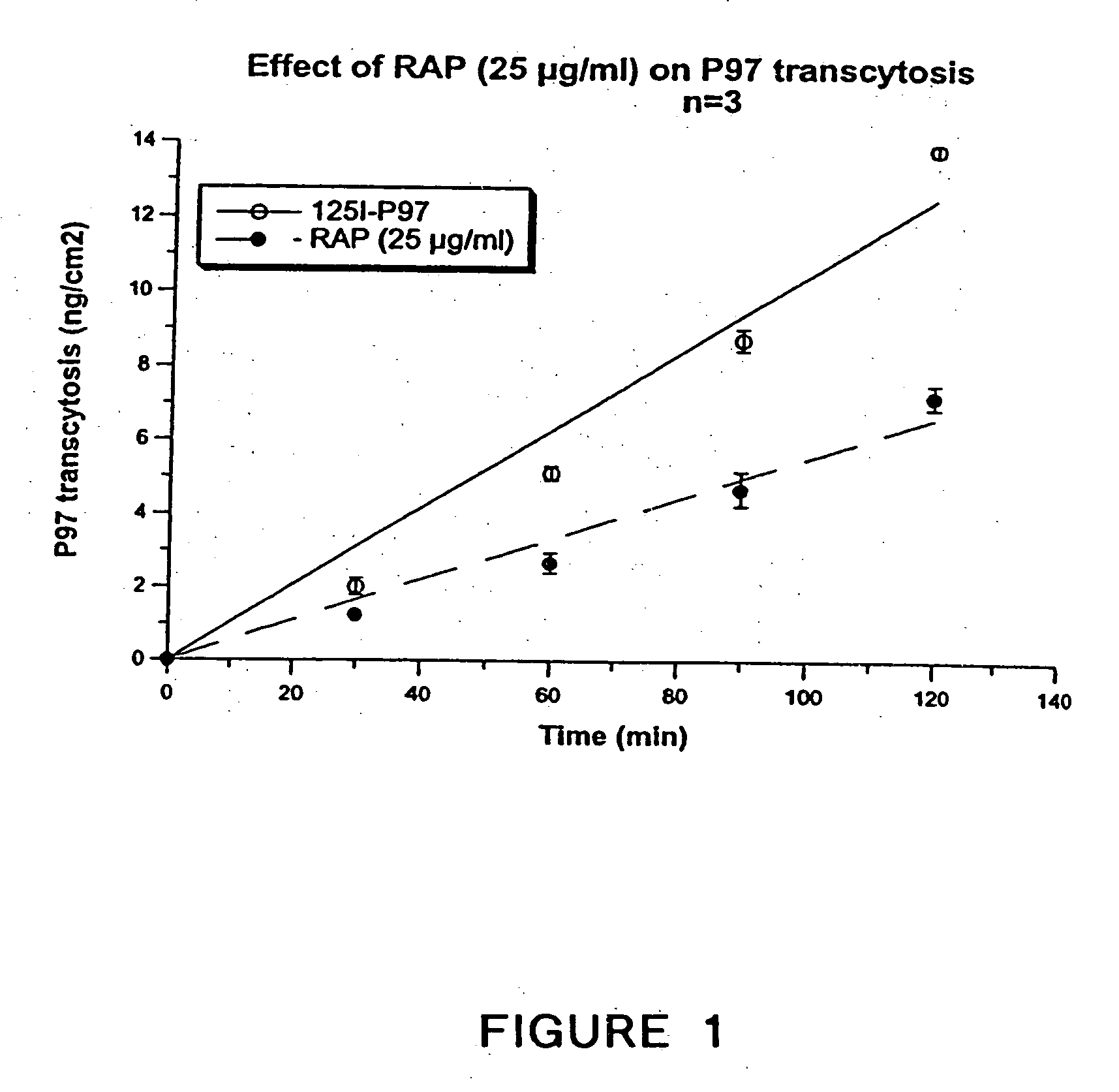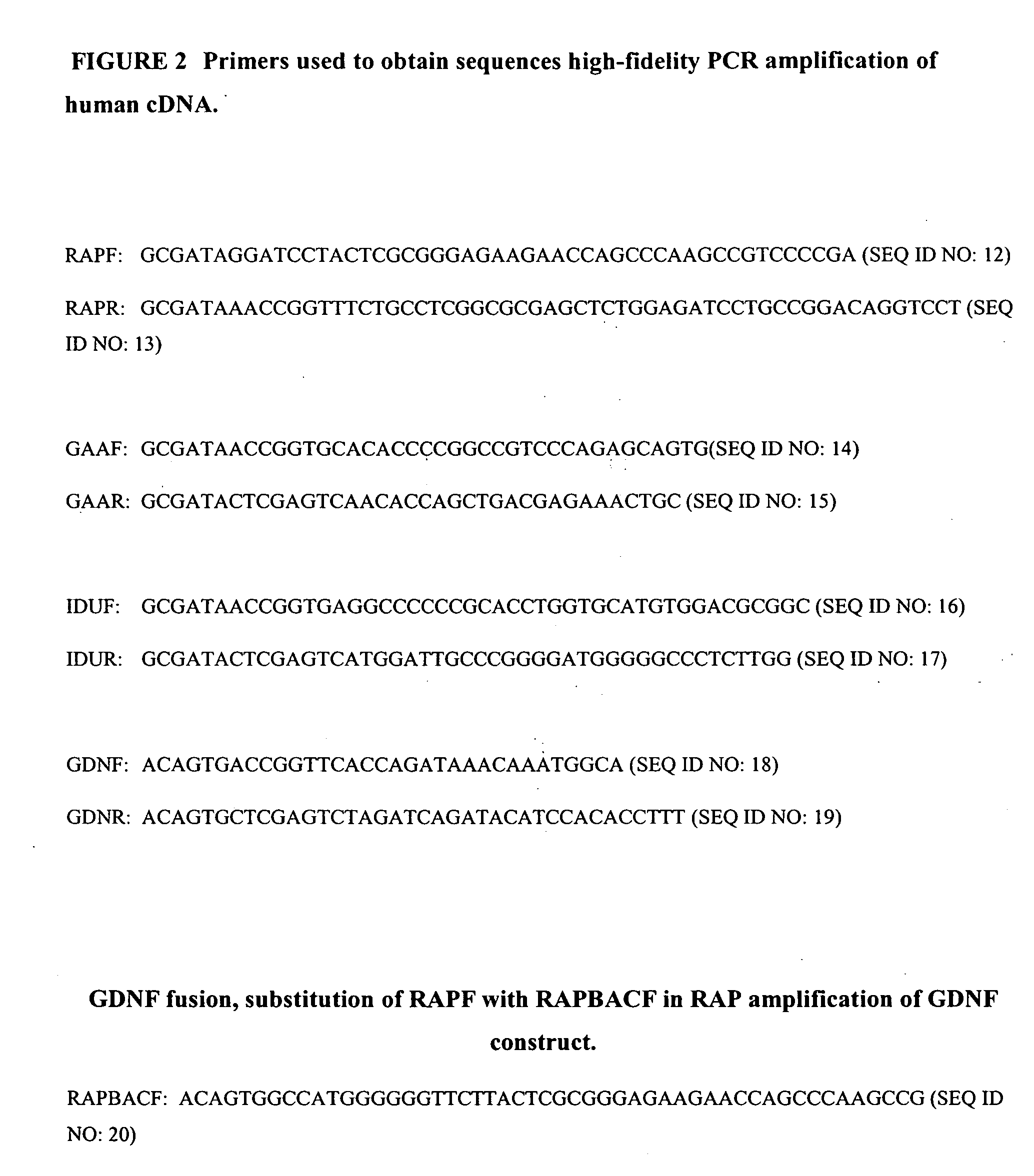Megalin-based delivery of therapeutic compounds to the brain and other tissues
a technology of megalin and therapeutic compounds, applied in the direction of parathyroid hormones, transferrins, drug compositions, etc., can solve the problems of significant impedement of the management of neurological manifestations of lysosomal storage diseases (lsds), bbb impedes access to beneficial active agents, and accumulation of undegraded “storage materials. , to achieve the effect of increasing the transpor
- Summary
- Abstract
- Description
- Claims
- Application Information
AI Technical Summary
Benefits of technology
Problems solved by technology
Method used
Image
Examples
example 1
Transcytosis of p97
[0270] Transcytosis experiments were performed as follows. One insert covered with bovine brain capillary endothelial cells (BBCECs) was set into a Transwell apparatus containing a six-well microplate with 2 ml of Ringer / Hepes and pre-incubated for 2 h at 37° C. [125I]-p97 (250 nM) was added to the upper side of the filter covered with cells. At various times, the insert was transferred to avoid re-endocytosis of p97 by the abluminal side of the BBCECs. At the end of experiment, [125I]-p97 was measured after TCA precipitation. Transcytosis is depicted in FIG. 17.
[0271] The effect of RAP on transcytosis of 125I-p97 was assessed. In FIG. 1, RAP, a known polypeptide inhibitor of the LRP family was applied to the cells (25 micrograms / ml). RAP significantly inhibited the transcytosis of p97, thus directly implicating the LRP family in transcytosis.
example 2
Construction, Expression, Purification and Characterization of RAP Fusions
[0272] Expression constructs encoding fusions between the human receptor-associated protein (RAP) and human alpha-glucosidase (GAA), alpha-L-iduronidase (IDU) or glial cell-derived neurotrophic factor (GDNF) were prepared. For this purpose, a sequence that encodes RAP was fused to the 5′-end of sequences that encode the different fusion partners. All sequences were obtained by high-fidelity PCR amplification of human cDNA with the following primers shown in FIG. 2a. The GDNF fusion was designed for expression in bacteria. To this end, primer RAPBACF was substituted for RAPF in the RAP amplification for this construct (FIG. 2b).
[0273] The 5′-end of RAP was truncated to remove the signal peptide sequence. Instead, an in-frame BamHI site, which encodes the dipeptide GS, was added for the mammalian expression construct. Sequence encoding the tetrapeptide MGGS with an NcoI site at the 5′-end was added for the bac...
example 3
Uptake and Distribution of Unconjugated RAP to the Brain
[0285] The distribution of RAP to brain was measured using a mouse in situ perfusion model. Volumes of distribution (Vd) for RAP, the positive control transferrin and the negative control albumin, were determined over a perfusion interval of 5 minutes. In addition, the relative quantities of the test proteins in the vascular and parenchymal fractions of the perfused brain were determined using the capillary depletion technique (Gutierrez et al., J. Neuroimmunol., 47(2): 169-76, 1993). The results shown in FIG. 11 include an observed, corrected Kinflux of 1 μL / g / min for transferrin. RAP had an observed, corrected Kinflux of 2.2 μL / g / min. RAP is taken up into brain.
[0286] A separate experiment was carried out at a single, 5-minute time-point to determine whether RAP is able to traverse the brain vasculature and enter the parenchyma. Brains were harvested as before, but were subjected to a capillary depletion procedure to determ...
PUM
| Property | Measurement | Unit |
|---|---|---|
| dissociation constants | aaaaa | aaaaa |
| Tm | aaaaa | aaaaa |
| molecular weight | aaaaa | aaaaa |
Abstract
Description
Claims
Application Information
 Login to View More
Login to View More - R&D
- Intellectual Property
- Life Sciences
- Materials
- Tech Scout
- Unparalleled Data Quality
- Higher Quality Content
- 60% Fewer Hallucinations
Browse by: Latest US Patents, China's latest patents, Technical Efficacy Thesaurus, Application Domain, Technology Topic, Popular Technical Reports.
© 2025 PatSnap. All rights reserved.Legal|Privacy policy|Modern Slavery Act Transparency Statement|Sitemap|About US| Contact US: help@patsnap.com



